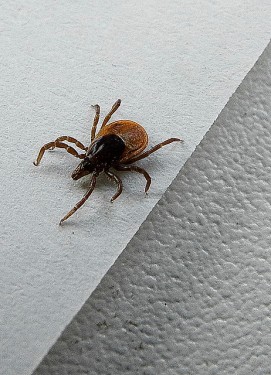
Lyme disease is transmitted from ticks to your dog (and potentially you) through a bite from an infected bug. Ticks are a common occurrence in Manitoba, and can be picked up by your dog almost anywhere! Last year there were 577 diagnosed cases of Lyme disease in Winnipeg dogs. Ticks are unable to fly or jump, so they lay in wait on long blades of grass (almost like a silent ninja!) for your dog to rub up against and then attach themselves to the host. It is very important to make sure you check your dog thoroughly after they have been outside in long grass for any ticks that may have latched on. Ticks enjoy hanging out in certain “hot spots†on your dog, such as right inside their ears, in their armpit area and on their chests.
Tick Removal
When removing a tick from your dog, make sure that you have a couple of things handy and ready to go beforehand: tweezers and a container filled with alcohol or peroxide to put the ticks in. Grasp the tick close to the skin with tweezers and pull slowly upward with steady pressure. Try to avoid twisting or crushing the tick and make sure that you don’t accidentally leave the head still attached to your dog. After the tick has been removed, cleanse the skin around the tick bite with soap/water or disinfectant. If the bite starts to scab over and your dog is uncomfortable, you can break open a Vitamin E tablet (purchased at any pharmacy or health store) and rub the liquid on the wound site.
Signs and Symptoms
Many pet owners will take to the internet to do research regarding Lyme disease in dogs, but won’t find a lot of literature that doesn’t focus on what the disease does in humans. The symptoms in dogs are quite different. For example, it is rare that a dog will develop the heart and neurological issues that Lyme disease causes for humans. Common symptoms include joint pain and fever, which won’t normally present until 2-5 months after the initial bite. Dogs with Lyme disease will sometimes exhibit lameness. Their joints may swell, causing tenderness and limping. Sometimes it is constant, sometimes it will go away and come back.
Other symptoms a dog may have the disease are swollen lymph nodes, walking stiff with an arched back, lethargy, being sensitive to touch, having difficulty breathing, and depression. Lyme-positive dogs can also develop kidney issues in the later stages of infection.
While many dogs live with this disease undetected, it is best to take your dog to the vet if you think they may be infected. Your vet will start your dog on a course of antibiotics to clear the disease from his body.
Prevention
Tick control is essential to the prevention of Lyme disease. Try to limit the amount of time your dog spends in tall grasses during the months of April-November (tick season) and check them regularly when they come inside from a walk. D.R.E.A.M. also recommends spraying your dog with an Eco-Friendly preventative spray such as our Rosemary-Lemon mix to help ward off uninvited visitors.
Your vet can recommend various preventative measures, such as sprays, collars and topical products for repelling and killing ticks. You must be careful when using such products if you have cats as they may be deadly to them. Vaccines are also available, although they are controversial due to a high number of side effects. In any case, a vet should be consulted for recommendation of an appropriate method and product.
D.R.E.A.M. can’t stress enough that prevention is the key to keeping your dog safe from Lyme Disease. A simple check of your dog before coming in from a romp in the park is a simple and effective way to search out ticks and remove them quickly before they cause any additional issues!

没有评论:
发表评论